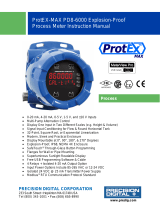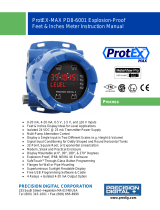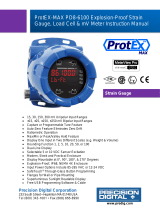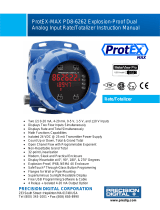3
Table of Contents
Table of Contents ----------------------------------------- 3
Table of Figures ------------------------------------------- 3
Introduction ------------------------------------------------- 4
Ordering Information ------------------------------------ 4
Specifications ---------------------------------------------- 5
General ------------------------------------------------------------ 5
Process Input --------------------------------------------------- 5
Temperature Inputs ------------------------------------------- 5
Relays Option --------------------------------------------------- 6
Isolated 4-20 mA Transmitter Output ------------------- 6
External Switch Contacts ----------------------------------- 6
Serial Communications -------------------------------------- 6
Product Ratings and Approvals -------------------------- 7
Compliance Information -------------------------------- 8
Safety -------------------------------------------------------------- 8
Electromagnetic Compatibility ---------------------------- 8
Safety Information ---------------------------------------- 9
Installation -------------------------------------------------- 9
Unpacking ------------------------------------------------------ 10
Pre-Installed Conduit/Stopping Plug ------------------ 10
Mounting ------------------------------------------------------- 10
Cover Jam Screw -------------------------------------------- 10
Connections --------------------------------------------------- 11
Required & Factory Wired Connections ------------- 11
Connector Labeling --------------------------------------- 12
Power Connections --------------------------------------- 12
Signal Connections --------------------------------------- 13
Serial Communication ------------------------------------ 15
Relays and 24 V Output Connections ---------------- 15
Switching Inductive Loads ------------------------------- 15
4-20 mA Output & Input Signal Connections ------- 16
External Switch Contacts --------------------------------- 16
Setup and Programming------------------------------ 17
SafeTouch
®
Buttons ---------------------------------------- 17
Front Buttons and Status LED Indicators ----------- 18
Display Functions and Messages ---------------------- 19
Main Menu ----------------------------------------------------- 20
Setting Numeric Values ----------------------------------- 20
Setting Up the Meter (setu) ------------------------------ 21
Setting the Input Signal (inpt) ------------------------- 21
Setting the Decimal Point (dc.pt) ---------------------- 22
Setting the Temperature Scale (F C) --------------- 22
Programming the Meter (prog) ------------------------- 23
Scaling the Meter (scal) -------------------------------- 23
Calibrating the Meter (Cal) ----------------------------- 24
Recalibrating Temperature Inputs (Cal) ------------- 24
Recalibrating Process Inputs (ICal) ----------------- 25
Setting the Relay Operation (rely) ------------------- 26
Relay and Alarm Operation ----------------------------- 28
Scaling the 4-20 mA Analog Output (Aout) --------- 31
Program the Sensor Break Output Value (SEbr) -- 31
Analog Output when Display is Out of Range ------ 32
Setting Up the Password (pass) ------------------------ 32
Locking the Meter ----------------------------------------- 32
Unlocking the Meter -------------------------------------- 32
Advanced Features Menu -------------------------------- 33
Advanced Features Menu & Display Messages --- 33
Offset Adjustment (Adj) --------------------------------- 34
Noise Filter (fltr)----------------------------------------- 34
Noise Filter Bypass (byps) ------------------------------ 34
Serial Communications (serl) ------------------------- 35
Protocol Selection Menu (Prot) ----------------------- 35
Select Menu (SElc) --------------------------------------- 35
Linear or Square Root Function (linr or Sqrt) --- 35
Low-Flow Cutoff (cutF) ---------------------------------- 36
Display Intensity (inty) ---------------------------------- 36
Meter Copy Function (Copy) ---------------------------- 37
Internal Calibration (ICal)------------------------------- 38
Operation -------------------------------------------------- 40
Front Buttons Operation ---------------------------------- 40
SafeTouch
®
Buttons ---------------------------------------- 40
Maximum/Minimum Readings--------------------------- 41
Service ------------------------------------------------------ 41
Mounting Dimensions --------------------------------- 42
Troubleshooting ----------------------------------------- 42
Diagnostics Menu (diag) ---------------------------------- 42
Determining Software Version ------------------------- 42
Reset Meter to Factory Defaults ------------------------ 43
Factory Defaults & User Settings ---------------------- 44
Troubleshooting Tips -------------------------------------- 45
Quick Interface Reference Guide ------------------ 47
EU Declaration of Conformity ----------------------- 49
Table of Figures
Figure 1: Integrated Trident X2 (PD8-765) Required
Connections ........................................................ 11
Figure 2. Labeling for 2 Relay, Analog Out, & 24 V
Supply .................................................................. 12
Figure 3. Labeling for Analog Out & Two 24 V Supply
Model .................................................................... 12
Figure 4. Power Connections ..................................... 12
Figure 5. Transmitter Powered by Ext. Supply or Self-
Powered ............................................................... 13
Figure 6. Transmitters Powered by Internal Supply
(Optional) ............................................................. 13
Figure 7. Voltage Input Connections ......................... 13
Figure 8. Thermocouple Input Connections ............. 14
Figure 9. Three-Wire RTD Input Connections ........... 14
Figure 10. Two-Wire RTD Input Connections ............ 14
Figure 11. Four-Wire RTD Input Connections ........... 14
Figure 12. Relay & 24 V Output Connections ............ 15
Figure 13. AC and DC Loads Protection .................... 15
Figure 14. Low Voltage DC Loads Protection ........... 15
Figure 15. 4-20 mA Output & Input Signal Powered by
Meter ..................................................................... 16
Figure 16. 4-20 mA Output Powered Externally ........ 16
Figure 17: External Switch Contacts .......................... 16
Figure 18: Enclosure Dimensions – Front View ........ 42
Figure 19: Enclosure Dimensions – Side Cross
Section View ......................................................... 42



























